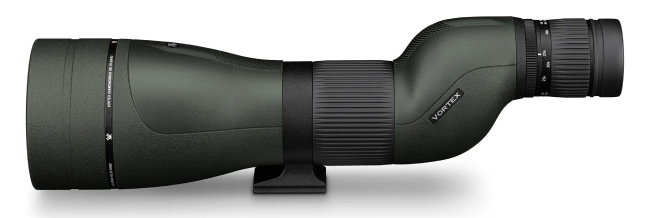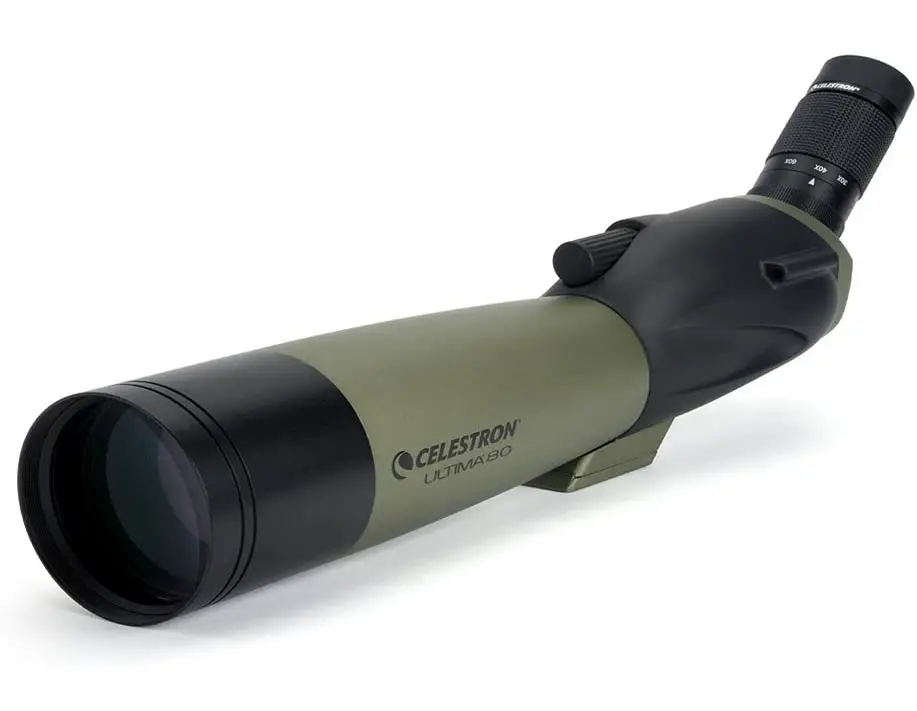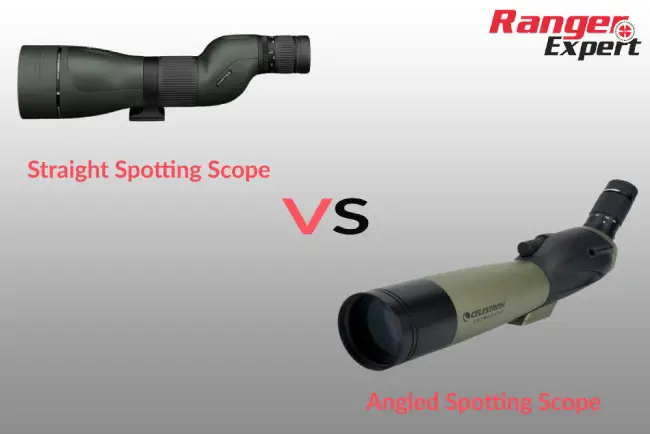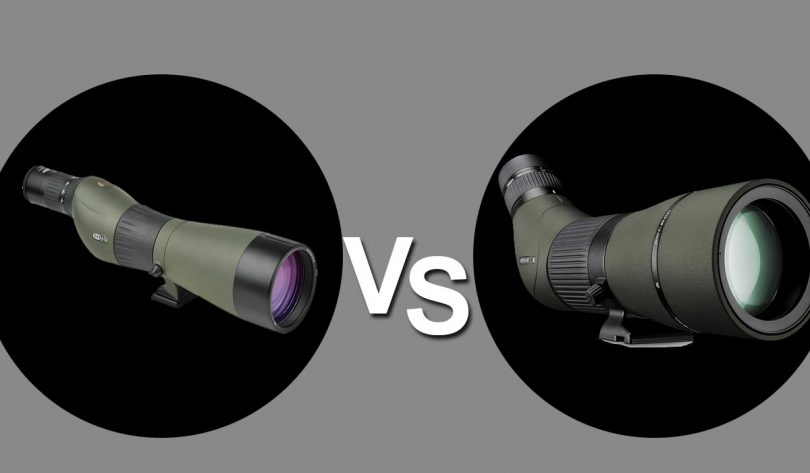Spotting scopes are essential equipment for anyone interested in bird watching, hunting, or astronomy. Spotting scopes come in two basic designs: straight and angled. Each type has its advantages and drawbacks that you should consider before purchasing.
Straight spotting scopes provide more comfort but lack versatility. Angled spotting scopes, on the other hand, provide improved versatility and better eye relief but is a bit tricky to use.
This guide will discuss the different applications, pros, cons, and features of those two scope types so you can choose the perfect one that fits your specific style of hunting!
Let’s dive into our in-depth “Straight Vs Angled Spotting Scope” comparison guide to find out more.
Straight Spotting Scope

Applications
The design of a straight spotting scope keeps the objective lens and eye piece mostly in a straight line or at least parallel to the land or ground.
Many straight spotting scopes contain variants known as the Porro prism in which the eyepiece is placed in line with, but a little above its objective lens. Straight scopes can be used for these specific activities.
Hunting and target shooting:
Since you require shooting at a specific point for hunting and target shooting, these spotting scopes can be conveniently used for faster target acquisition.
If you want to become a professional sniper, you will probably spend most of your time with a straight spotting scope rifle.
Straight spotting scopes will also help you shoot your target from a tree stand.
Nature Observing:
A straight scope can be the best choice for you to observe nature.
Also, a straight spotting scope can be really useful if you love to view what is happening under the deep sea.
Car Mounts:
You can use them to trace the target while moving in a car or even from a parked car.
Who Can Choose a Straight Spotting Scope?
All professional hunters, especially beginners, can easily use this spotting scope. Because they are user-friendly and convenient.
Where You Can Use the Straight Spotting Scope?
Straight spotting scopes are specifically beneficial to use for any type of hunting and target shooting.
They are convenient for regular hunting and shooting from ridgelines, blinds, and car mounts. It can be helpful to observe the sea life or nature too.
Pros of Straight Spotting Scope:
1. Easy to use
Using a spotting scope with a straight eyepiece is much easier than using an angled one. You will adjust your angled scope to have a better view of your target, but you will be able to apply your inbuilt direction sense while using a straight scope.
When you are spotting or shooting from a hiding place, you can carry this spotting scope conveniently. If you prefer using it from higher places such as tree stands, you should use this type of spotting scope. There are also some great tripods for spotting scopes that you can use to make your spotting easier.
2. Faster and easier target acquisition and tracking
As mentioned above, they are easy to use. Your target will be easily acquired and tracked faster using this spotting scope.
As you will always face in the same direction, you can easily look up from your scope, see with the naked eye, and switch back to your scope without turning away from your target.
3. Protection From Dust, Debris, Snow, And Rain
The eyepiece remains in a straight direction so it doesn’t collect dust, debris, snow, and rain so easily.
4. Convenient to track moving objects
Tracing moving objects, such as in professional snipping training/hunting, is easy with a straight spotting scope because it makes you track and find your target easily.
5. Versatility
Seasoned observers/hunters will first have an overall view of the landscape with a pair of regular/hunting binoculars to get a target applying their wider scope of view.
Then they will switch to the spotting scope to have a closer look. If you use a straight scope, you don’t need to adjust the tripod height after this switch, adding a layer of convenience to your hunting trips.
6. Awesome Transportability
Hunters packs and day packs often come with scope sleeves. Your straight scopes will fit more easily into these.
Also, the straight models are much smaller and lighter than their counterparts. That makes them more transportable. The lack of tripod angle adjustments also adds to the ease of portability.
Cons of Straight Spotting Scope
1. Difficult To View From A High Angle
With a straight spotting scope, It’s painful to view at a severely higher angle, to target things at high altitudes or altitudes above sea level. This type of straight spotting scope cannot be used from higher grounds.
2. Uncomfortable For Prolonged Use
You need to stay in a single posture for long to use this type of scope. This can cause discomfort, particularly if you are viewing it from various angles, or keep using it for long periods of time. This can cause neck discomfort if you need to constantly bend.
3. Lacks Advanced Features
These scopes are generally inexpensive but don’t have advanced features like their angles counterparts. Due to the lack of features, they are limited in their use. This is also a reason the image created in this type of scope can be of lower quality.
4. Difficult To Use For Digiscoping
This scope is tough to carry for digiscoping because it can sway sideways and become unstable because of the heavyweights of the camera and adapter.
You may need to adjust your tripod angle after every picture, which can be a hassle. This can also damage the scope’s eyepiece.
5. Dependable On Accessories
The use of accessories is a must with these types of scope. For instance, when you’ll need to spot something from above the ground, you’ll need a tripod.
You surely know tripods are expensive and difficult to carry. And the tripod needs to be higher or taller, which increases the effect of wind on this scope.
Angled Spotting Scope

Applications
The angled spotting scope is designed so that its eyepiece is placed at a specific angle with respect to its barrel.
Mostly, the angle ranges from 45 to 90°, and this angle is not adjustable. But the eyepiece can be rotated around your scope, which gives versatility in specific positions.
This spotting scope can be applied for activities like
Astronomy:
Astronomers require watching distant things from different angles and distances. Even though spotting scopes aren’t as powerful as telescopes, they are an excellent resource for amateur astronomers.
Birding:
Angled spotting scopes provide a comfortable and effortless way of viewing birds while maintaining an upright posture.
If you need clarification about choosing an angled vs straight spotting scope for birding, go for an angled one as they’ll make your birding session stress and strain free.
Hunting:
The hunters prefer the angled scope because they require chasing down the targets, and watching them from various angles helps them prepare for the best chance.
Whether hunting from a tree stand or from the ground, an angled scope will offer you a comfortable yet efficient experience.
Digiscoping:
These spotting scopes can also be easily used for digiscoping. They are perfect for taking pictures of wildlife and landscape with the help of a camera or smartphone adapter.
Who Can Choose the Angled Spotting Scope?
These devices are difficult to use because the line of sight always remains on a slope angle, making it difficult to track the moving targets.
This scope isn’t for everyone. Only professional hunters with prior experience can use this spotting scope in the right way.
Where You Can Use the Angled Spotting Scope?
You can choose this versatile spotting scope to use in astronomy, birding, bird hunting, other hunting, and digiscoping.
Pros of Angled Spotting Scope
1. Easy to Share
An angled scope is set like the classic telescope because you place this scope on your tripod and align its eyepiece upwards.
So, you will need to bend over to look into the scope. The advantage of this is people of various heights can easily use it without changing the setup.
Also, you can mount angled scopes on tripods much lower than the straight ones to have the same output, i.e., you don’t require a tall tripod.
A small tripod means less room and less weight in your pack.
2. Comfortable Posture
It is easy and comfortable to bend it upwards and view objects in the sky and high terrain since you usually are above this scope, watching into its eyepiece.
The slight tilt over the head in a forward direction is more convenient for prolonged observations because you can sit or lie down.
3. Steady Performance
You’ll need lower tripods to mount this scope, so it can be easily used outdoors on windy days.
Because the center of gravity works closer to the ground and makes your tripod steadier in windy situations. This is one of the main reasons many choose this type in the “angled vs straight spotting scope” debate.
4. Convenient to use
Put your hunting pack on a raised part of the ground and set the scope on its top.
Now you can conveniently lie down and have a nice angle on your scope for viewing rather than what you can have through a straight-angled scope.
These are also great for long-term use. Suppose you have taken part in competitive shooting, and your setup position is well. Moving your head slightly can easily switch from a rifle scope’s eyepiece to a spotting scope.
Competitive shooters apply their spotting scope’s wider fields of view to check shot results and wind directions regularly. They do not want to move out of their shooting position to do so.
5. Better for Astronomers
The angled eyepiece and the fact that the scope makes looking upwards more natural like a telescope indicates that this scope is better for astronomers to use.
A magnification scope of 60x on a clear sky at night can help you view the moons of Jupiter. Indeed, a straight scope has the same capabilities, but an angled one will give you more comfort while doing so.
Cons of Angled Spotting Scope
1. Difficult to use
If you want to observe from a higher place such as a tree stand, you can’t use this device. Because the barrel and eyepiece are placed at a certain angle. It will also be a bit difficult to use from any hiding place or let’s say, a moving vehicle.
Additionally, angled spotting scopes require some handling experience. So, it is difficult to use for beginners.
2. More Expensive
Generally, these scopes are more expensive than the straight ones. The reason for this is that angled spotting scopes have more advanced construction and better optics.
6. Low Portability
These scopes are heavier than the straight ones. They are designed to be mounted on a tripod, and if you want to carry them for long distances, it can be a bit of a burden.
It will be difficult to put into your pocket, and troublesome to put into the backpack when it is full.
7. High Maintenance
Since the lens is angled at about 45 or 50 degrees, it is easily exposed to dust, snow, and rain. Just throw your hat on the eyepiece or keep the eyecap closer to put on the eyepiece when not in use.
In addition, you’ll need to clean the lenses once in a while because they are prone to water and dirt. This requires regular maintenance, which needs to be done by professionals.
You also need to keep the lenses protected from knocks and bumps and store them in a safe place.
Straight vs Angled Spotting Scope – Based on Purposes

For Birding
The first and foremost thing in viewing birds is comfort.
Angled spotting scopes can give you this comfort in viewing birds without any neck pain.
Because for looking at an angle around 80 degrees or the like, you can look at the device’s eyepiece while maintaining zero degrees from your head. You don’t require looking upwards, stressing your neck.
A straight spotting scope cannot give this comfort, which is why an angled scope easily wins the Straight Vs Angled Spotting Scope debate when it comes to birding.
For Astronomy
Using a straight spotting scope for astronomy will give you neck pain and make the task difficult.
The exact choice should be an angled spotting scope. You can see long-distance things at a specific angle with this device without pain in the neck.
And for the same reason, this title also goes to the angled spotting scope.
For Digiscoping
The optical quality of both scopes is the same in this aspect.
An angled one will keep your camera at a downward angular position to you. It will make it more convenient to see and share what you are doing in a suitable position.
On the other hand, a straight one can turn it quicker to find out a target or subject and can avoid more glare of sunlight on the camera screen.
As a result, there’s no particular winner in the straight Vs angled spotting scope. Using an angled scope with a heavyweight adapter that can swing away your camera from the eyepiece will provide better results.
It will keep your camera “at rest” in a downward angular position and help to keep it strong against the device’s eyepiece.
For Car Window Mounts
If your car is big compared to your body structure, you will have enough space for moving around in the seat and angling a straight spotting scope the way you like it.
An angled scope with its adjustable eyepiece allows you to set the scope for observing more angles than is possible with a straight one.
Directly point it in front of the car, and you won’t need to keep your head out of the car window to use it.
The same thing applies to behind and upward. You can position these angled scopes more comfortably.
So this round of our spotting scope angled vs straight comparison also goes to the angled scope! And with this, the official winner for our today’s in-depth comparison is the angled spotting scope!
Straight or Angled Spotting Scope – Which is Right for You
Now that you know all the applications, advantages, and disadvantages of both spotting scopes, you can easily choose which one is right for you depending on your experience and situation.
However, the winner of this debate isn’t universal, meaning it can change depending on your experience level and purpose.
Now. let’s explore which type of scope works better under which conditions.
An angled one can be preferable for these reasons:
Stability and versatile eyepiece positions
Now that you know all the applications, advantages, and disadvantages of both spotting scopes, you can easily choose which one is right for you depending on your experience and situation.
However, the winner of this debate isn’t universal, meaning it can change depending on your experience level and purpose.
Now. let’s explore which type of scope works better under which conditions.
An angled one can be preferable for these reasons:
Neck Relief
The angled one is right for situations when you are watching straight in front of you, sitting down, or even viewing from a small stool or chair.
These scopes make you bend your head a little down which is comfortable for prolonged sessions.
You can often also enjoy turning the eyepieces to the two to three o’clock or the ten to eleven o’clock position.
These positions also feel natural, and changing from one side to another gives one of your eyes a break!
Quick Maneuverability
Suppose you are waiting for an animal to stand so that you can catch that action. In those cases, keeping the spotting scope next to your rifle would be the best.
An angled spotter is ideal for such a situation because you can just turn your head to the left while looking through your spotter.
This will be much easier than looking through the rifle scope for hours while waiting or having to bend upward to look through the straight spotter.
Angled Vs Straight Spotting Scope: Which Is Better For Hunting
Contradictory to popular belief, the better option for novice hunters and target shooters is the straight spotting one.
These scopes remain at your eye’s horizontal level, and no need to change the settings or set the angle, as in the case of angled ones.
Hunters with all skill levels, including beginners, can easily use this device alongside their hunting scopes. However, it all comes down to your personal preference.
If you want to use either one, consider your specific type of adventure and the time you’ll be using the scope. If you need to use the scope for a prolonged time, don’t forget to take the necessary mounting options.
Angled scopes are for expert shooters, where distance measuring and angle setting are the two major concerns for getting effective results.
FAQs
How Powerful Should A Spotting Scope Be?
The power of a spotting scope is determined by its magnification. The higher the magnification, the more you can see from a distance. A typical high-power spotting scope will have at least 20x-30x magnification, allowing you to view objects up to 10 miles away.
Do Spotting Scopes Measure Distance?
Although spotting scopes are potent tools for viewing objects from a distance, they cannot measure the exact distances of those objects. A rangefinder is the best way to measure the distance between two points.
Do Spotting Scopes Have Reticles?
Some spotting scopes are equipped with reticles, which are crosshairs or lines etched into the lens. The reticle can be used to measure angular measurements or distances between two points in a field of view.









Leave a Comment